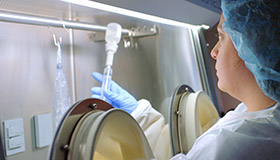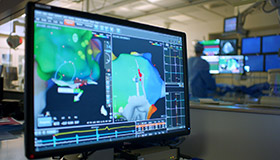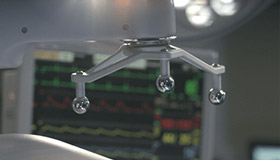Robotic Surgery Treats Mitral Valve Prolapse
From bad to worse
Robert’s symptoms were significant when his cardiologist first diagnosed him with mitral valve prolapse. This condition occurs when two flaps of tissue on the heart’s mitral valve (called leaflets) bulge into its left upper chamber when it beats. But mitral valve prolapse isn't life-threatening on its own and typically doesn't require treatment or lifestyle changes.
To see what treatments – if any – could help Robert, his cardiologist referred him to Dr. McGregor, director of robotic and minimally invasive heart surgery at AHN. But as Dr. McGregor evaluated him, he discovered a more serious problem.
Robert was experiencing mitral valve regurgitation – a downstream effect of his mitral valve prolapse. In fact, Robert’s mitral valve prolapse was so severe that it led to a flail leaflet. A flail leaflet develops when the supporting connection between the mitral valve and the heart breaks.
A flail leaflet is similar to a parachute whose strings broke. A parachute with broken strings cannot provide the air resistance needed to stay lifted in the air. Similarly, a mitral valve with a broken connection cannot provide the resistance needed to keep blood from leaking backward.
Small leakages may not cause complications. But larger leakages – more severe mitral valve regurgitation – can cause shortness of breath, fatigue, and lightheadedness. They can also be life-threatening.
The severity of Robert’s leakage made him a good candidate for robotic and minimally invasive heart surgery – and AHN is the only program in western Pennsylvania* that could do it using the da Vinci Surgical System.
Robotic surgery to the rescue
Dr. McGregor performed Robert’s surgery with the da Vinci System. Robotic surgery is minimally invasive, allowing surgeons to operate through a few small incisions. It also increases the precision of a surgeon’s hand movements. These precise movements help make reconstructive work on valves possible.
Most importantly, with robotic surgery, patients can experience:
- Less time spent in the hospital and intensive care
- Shorter recovery times
- A faster return to independence and lifestyle (one to two weeks with robotic surgery versus four to six weeks with traditional heart surgery)
- Minimal scarring
What’s more, in more than 90 percent of da Vinci mitral valve repair surgeries, the breathing tube is removed in the operating room. With traditional surgery, the patient has to wake up with the breathing tube still in place.
“We have the data, have done the analysis, and know that this is much better for patients,” Dr. McGregor said. “It’s with great pride that we’ve been able to develop this for the benefit of people.”
Getting patients back to their lives
The procedure repaired Robert’s heart valves, allowing his blood to flow properly.
“The ultimate goal for mitral valve repair surgery patients is to get them back to their lifestyle promptly,” Dr. McGregor said. “Most patients are back within six weeks and with more energy.”
Contact us
Request an appointment with one of our experts or get more information about the Allegheny Health Network Cardiovascular Institute.
Permission granted by Intuitive Surgical
*Western Pennsylvania excludes Erie.





